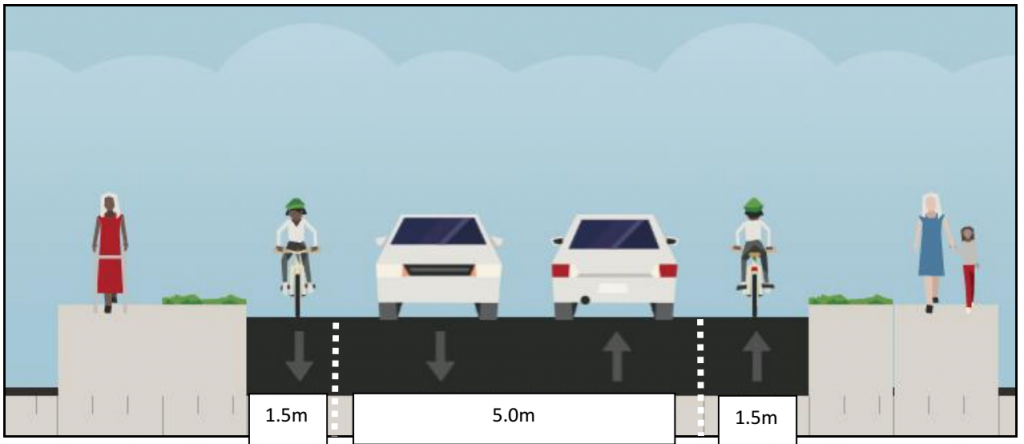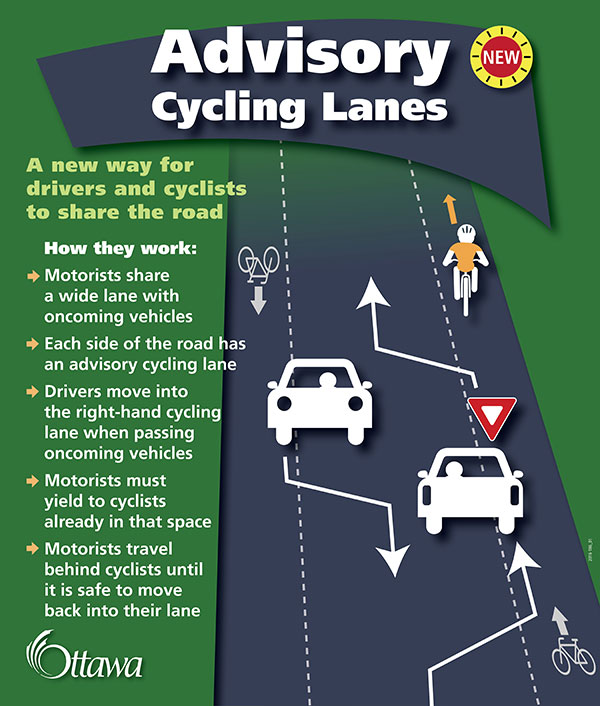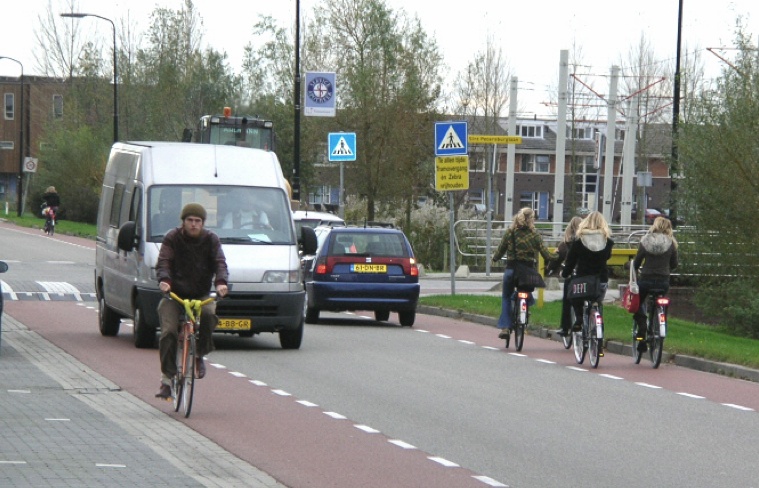Krug Street is an important piece of Kitchener’s Cycling Master Plan. It’s one of the precious few roads that crosses the Conestoga Parkway that doesn’t have dangerous on or off ramps, and doesn’t carry heavy traffic. Portions are currently being reconstructed, and with that work comes the opportunity to integrate cycling facilities on the street.
However, Krug can be quite narrow in places, as little as 8 m in some blocks, which doesn’t have room for full bike lanes and car lanes wide enough for buses to pass. Widening the roadway has been ruled out, as this would remove significant tree cover which improves the safety and walkability of the street.

The solution city staff are recommending is to put “advisory bike lanes” on the narrower portions. Advisory lanes would have the full width of bike lanes, but would be dashed instead of solid lines. The middle section of the road would be narrower than two conventional traffic lanes, with no centre line. Motorists would be expected to use the middle section, except when approaching an oncoming vehicle, at which point they would be allowed to pull into the advisory lanes, yielding to people cycling in them.
 It’s certainly not an ideal situation, but it’s a design that has been used commonly in the Netherlands, and more recently, in Ottawa and Minneapolis. It’s also mostly limited to the narrowest sections, with solid line bike lanes elsewhere. There are a few other concerns with the proposal that we’d like to see corrected – mandatory buffers are missing between parking spaces and bike lanes, some sections have excessively wide lanes that will induce speeding, and most egregiously, advisory lanes are proposed between East and Dumfries to shoehorn in extra parking spaces. But it’s greater separation between cars and bikes than what sharrows or just a signed route would provide, and has some continuity rather than making the bike lanes disappear entirely where they wouldn’t otherwise fit.
It’s certainly not an ideal situation, but it’s a design that has been used commonly in the Netherlands, and more recently, in Ottawa and Minneapolis. It’s also mostly limited to the narrowest sections, with solid line bike lanes elsewhere. There are a few other concerns with the proposal that we’d like to see corrected – mandatory buffers are missing between parking spaces and bike lanes, some sections have excessively wide lanes that will induce speeding, and most egregiously, advisory lanes are proposed between East and Dumfries to shoehorn in extra parking spaces. But it’s greater separation between cars and bikes than what sharrows or just a signed route would provide, and has some continuity rather than making the bike lanes disappear entirely where they wouldn’t otherwise fit.
And since there is likely going to be some pushback over the loss of some existing (and sparsely used) parking, it’s important that constructive feedback be received by staff and local councillors. Please take a few minutes to send some comments by Friday. (More details of the proposed designs here.)


Heads up: I tried to use the form, but I think it may not be working correctly— I never received my response back in my own email.
Hi Mike. There’s sometimes a delay in some email providers like Gmail when receiving a message that purports to be from yourself. I assume it’s just taking some time figuring out it’s not spam.
Thanks for bringing attention to the Krug street project and facilitating comments to the project manager. Wouldn’t it be best to include the three questions in the information package provided by the city (and linked to above)? Namely: (1) What do you consider to be the traffic issues (if any) on Krug Street?, (2) Do you feel there is a specific area of concern that can be address through this process?, and (3) General comments.
As two questions:. Why the change? What is it going to accomplish?
4th option: No bike lanes and vehicles just go around the bicyclist like the drivers are taught to do. I drive a vehicle or ride my electric bike (moped) down this street often and very few bikes are ever on it and I never had any issues while on my moped the way the road currently is. There is not enough bycicle traffic to go to such a great expense to make separate lanes on each side. There are more motorized vehicular traffic and to make it down to 1.5 lanes is just rediculous and dangerous. Drivers will have to have lessons on how to execute your diagram. Very few people will know how to deal with a single lane going both directions.
A lot of middle school kids ride Krug, but feel unsafe, thus ending up on sidewalks. This is not ideal. I’m not sure what solution is best, but I would like to see some sort of bike lane put in place. My kids and I use that stretch of road often.
Speed will be an issue without separation of oncoming traffic. The legal relative closing speed between vehicles will be 100kph, possibly reaching 120kph at the 80th percentile reported in the traffic study. Cars will end up darting into and out of the bike lanes too quickly. I can only see this design working safely at a considerably lower speed limit. 30kph is the maximum speed compatible with cyclist and pedestrian survival -we really should be aiming for that for so called designated “on road bike routes.”
*I had trouble with the form as well and sent an email manually. Probably duplicated it.
Advisory bike lanes are an okay option on streets with extremely low speeds and volumes, but they are completely pointless unless both of those conditions are true.
Yet I don’t see any evidence in the report that the City plans to reduce the speed limit to 30 km/h to allow this design to operate safely. And my experience of Krug is that while it’s not a particularly busy street, it is still busy enough that you’d encounter an oncoming car every few seconds, which is too frequently for the intended operation. Rather than driving in the centre lane and pulling into the bike lane when necessary, drivers will just drive in the bike lane. To reduce traffic volumes sufficiently, the City would need to make the street discontinuous for motor traffic, by placing a barrier somewhere along it that only bicycles, buses and emergency vehicles can pass.
There are also some questionable allocations of road space on the sections with reserved bike lanes. The absolute minimum allowable lane widths are 1.5m for a bike lane, or 3.0m for a traffic lane on a minor street, and the recommended minimum widths are 1.8m for a bike lane, or 3.3m for a traffic lane on a minor street. When there are space constraints, you’d expect the lanes to all be narrowed similarly, but that’s not what we see.
On Page 6 and Page 8, the bike lanes are the absolute minimum width allowed (1.5m), while the traffic lane widths range from generous to excessive (which promotes speeding).
Then on page 10 (under the Conestoga Parkway), the bike lane adjacent to parking is actually narrower than the minimum 1.8m required by the Ontario Traffic Manual. And much of that parking isn’t even legal in the first place, under Kitchener’s Traffic Bylaw Part V, 7(iii), which states:
“Unless otherwise permitted in this by-law, no person shall stop a vehicle on a highway: […] On, under or within 30 metres of a bridge, elevated structure, tunnel or underpass; […]”